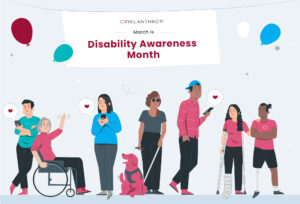Triple-Negative Breast Cancer Survivor Stories
Though there are several different types of breast cancer, each type falls into one of two overarching categories: invasive breast cancer or non-invasive breast cancer. Triple-negative breast cancer often referred to as TNBC, falls under the aggressive category of breast cancer types. This means it grows and spreads rapidly and can be tricky to treat, but that doesn’t mean there aren’t survivor stories.
Yet despite the challenges, with a correspondingly aggressive and progressive treatment plan, many cases are manageable, albeit expensive. Nevertheless, many patients are able to fund their treatment through financial assistance and donations from people just like you and me. Survivor stories help to remind us that not all is lost. There is hope, but that comes from research and community support.
That’s why we are extremely proud to tell you about our partnership and matching campaign with Breastcancer.org, the world’s leading online resource for breast health and cancer information! Together, we’re bringing you the exciting opportunity to double your impact: when you grant funds to Breastcancer.org through Philanthropi, we’ll match* your donation.
Triple-Negative Breast Cancer
This type of invasive breast cancer is called “triple-negative” because it tests negative for the three primary targets of breast cancer treatments:
- Estrogen receptors
- Progesterone receptors
- HER2 protein
This means that hormone therapy is typically considered to be an ineffective treatment tactic. As a result, chemotherapy is almost always part of a triple-negative breast cancer treatment plan.
Triple-negative breast cancer accounts for about 10% of all breast cancer cases, and represents about 12% of all invasive breast cancer cases. Additionally, triple-negative breast cancer is more likely to come back than breast cancer types that test positive for hormone receptors and the HER2 protein.
Good News for Advancements in the Field
Though triple-negative breast cancer is a daunting diagnosis, the medical field has been actively dedicating more attention to this challenging illness. Recent progress in the study and treatment of triple-negative breast cancer provides both early-stage and advanced-stage patients with newfound hope and optimism.
Some of the more significant and exciting advancements include the following:
Research and studies that involve antibody-drug conjugates, also known as ADCs, aim to broaden clinical usage and patient eligibility.
For instance, professionals at the 2022 San Antonio Breast Cancer Symposium discussed the ADC sacituzumab govitecan, an FDA-approved treatment for eligible patients with either local or extended advanced TNBC that can’t be removed via surgery. Additionally, they must have participated in at least two systemic therapies, with at least one for metastatic disease.
Patient success following the integration of an immunotherapy element into treatment plans.
Jane Janeczek of Pennsylvania decided to take a chance and incorporate the immunotherapy drug Keytruda into her triple-negative breast cancer treatment plan. Less than a year later, Jane feels much better and enjoys an active lifestyle.
Research and development efforts focus on identifying effective novel immune checkpoint inhibitors and blockades.
For instance, a Northwestern Medicine study published in January of 2023 shows that mitigated levels of CD73 proteins help promote an adaptive response to cancer cells from your immune system.
Progress in a study to develop a triple-negative breast cancer vaccine.
In 2021, the Cleveland Clinic began a study to research and develop a vaccine for triple-negative breast cancer. In early February 2023, the Clinic initiated the next phase of the study, which is scheduled to run its course by the end of the year.
Are there Triple-Negative Breast Cancer Survivors?
Since triple-negative breast cancer is aggressive, survival rates are generally lower than rates for other breast cancer types. Nevertheless, many women have overcome TNBC, moving forward with happy and healthy lives.
The Surveillance, Epidemiology, and End Results program, or SEER, collects data to determine 5-year survival statistics for individuals diagnosed with triple-negative breast cancer. The SEER program has organized the data into groups based on how far breast cancer had spread at the time of diagnosis.
Based on data captured between 2012 and 2018:
|
Cancer Stage |
5-Year Survival Rate |
|
Localized |
91.3% |
|
Regional |
65.8% |
|
Distant |
12.0% |
However, it’s pivotal to remember that with advancements like those mentioned in the section above, we may see the rate increasing in years to come.
Is there a Cure?
Unfortunately, there is not a triple-negative breast cancer cure at this point. But on the bright side, a cure might not be as far away as it once seemed. People are dedicating the necessary time to advance our treatment capabilities every day, and we all have the opportunity to contribute to and participate in the effort.
Secondary Triple-Negative Breast Cancer
What is Secondary Triple-Negative Breast Cancer?
Though the name is a mouthful, the meaning is relatively simple to break down and understand.
Secondary breast cancer refers to a type of breast cancer that has spread to additional parts of your body. You might have already heard of this, but by a different name, such as:
- Stage 4 breast cancer
- Metastatic breast cancer
- Advanced breast cancer
Secondary triple-negative breast cancer means that this specific type of invasive breast cancer has already spread to other parts of your body. Unfortunately, this stage of breast cancer can very rarely be cured. However, it can be treated, and as we’ve learned above, treatments are taking significant steps and leaps in the direction of improvement.
While we still have a lot of distance to cover and a lot of work to do, we’ve already come a long way.
Together, we can help our community live longer. We can create more Triple-Negative Breast Cancer Survivor Stories. Together, we can double the impact and weight of a donation. Sign up for a Philanthropi Impact Account today, and when you donate to Breastcancer.org, Philanthropi will match* your donation.
* Philanthropi will match up to $5,000 total within the month of March 2023.
Learn More about how to donate towards Triple Negative Breast Cancer Awareness on the Philanthropi Platform.
FAQs
Are there any survivors of triple-negative breast cancer?
- Yes! Even though this type of cancer is very aggressive, there are triple-negative breast cancer survivors. You can connect with survivors and read about their stories here.
What is the longest survival for triple-negative breast cancer?
- While we can’t know that it’s the longest, a woman in her fifties diagnosed with secondary TNBC has survived for over 15 years!
Can you be in remission from triple-negative breast cancer?
- Yes, it is possible to achieve remission from TNBC.
What is the newest treatment for triple-negative breast cancer?
- Researchers from the Moffitt Cancer Center published a TNBC treatment study indicating that an oncolytic virus treatment integrated with chemotherapy can enhance response rates during neoadjuvant TNBC therapy.
Does triple-negative breast cancer have a good prognosis?
- Every individual and their situation is different, but as far as breast cancer diagnoses go, TNBC doesn’t have the most promising prognosis. Due to its aggressive nature, not only can TNBC grow, spread, and advance through the body at a fast pace, but it’s also more likely to come back.



